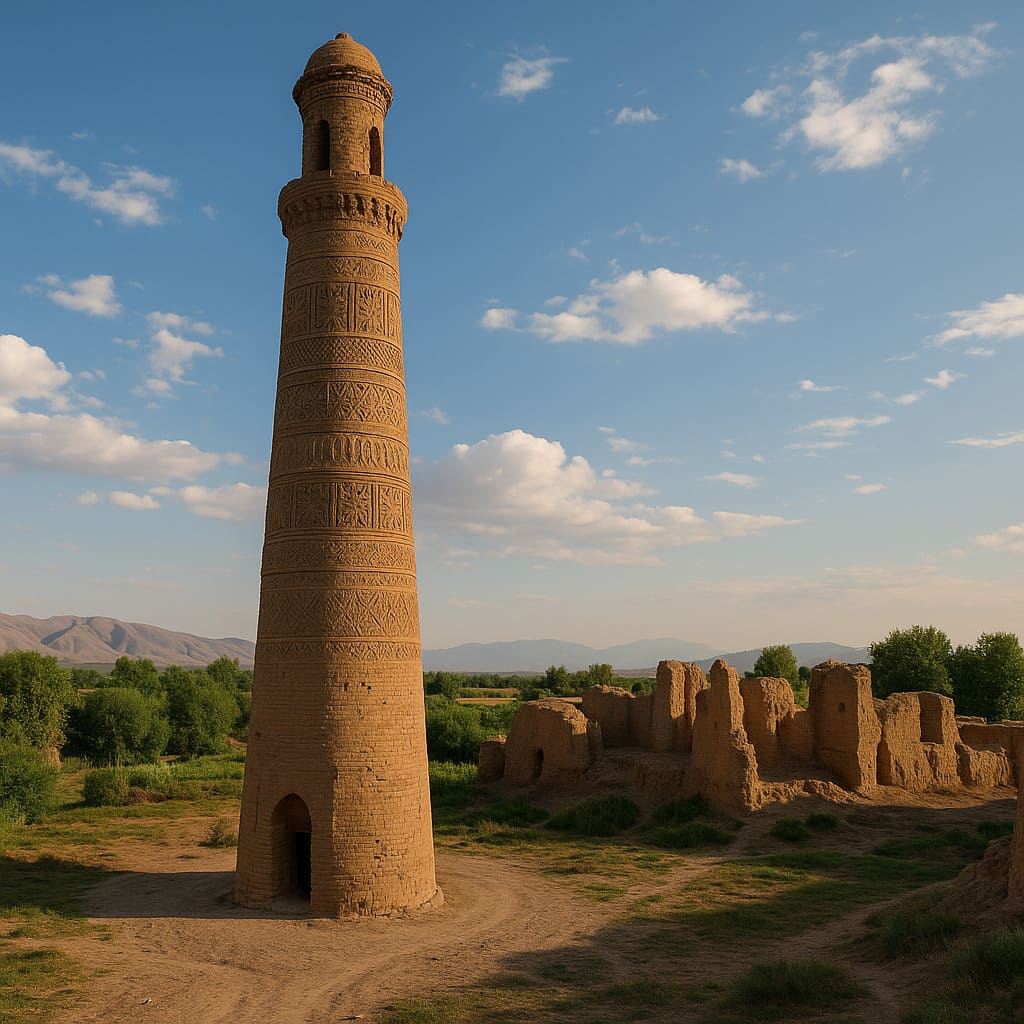Goshta Minaret in Goshta District, is one of many fascinating sites that both foreign visitors and local tourists can explore while they visit Afghanistan and exploring Nangarhar Province. Tucked away in the heart of the ancient land, it unfolds centuries of civilization, grandeur, and tales of human triumph. Unraveling layers of history and culture, where each brick tells a story and every archway provides a glimpse into a splendid past, Goshta Minaret is a captivating destination for avid explorers, photographers, and history enthusiasts.
Goshta Minaret Most Important Events
- The Construction of Goshta Minaret: The creation of Goshta Minaret, dating back to the 12th century, is a pivotal moment. This period marked an architectural revolution, with the minaret showcasing the fine balance between artistic brilliance and technical prowess.
- Afghanistan’s Historic Era: The era of the Ghorid Dynasty was influential, during which Goshta Minaret stood as a symbol of growing Islamic influence and cultural amalgamation. It played a significant role during the transition period, reflecting the changing socio-political dynamics.
- Recognition by UNESCO: A significant development was when Goshta Minaret achieved recognition from UNESCO. This brought the monument global attention and boosted its stature in the world of travel and history.
History of Goshta Minaret in Goshta District
The history of Goshta Minaret traces back to approximately 1100 AD, in the times of Ghorid Dynasty. The tower, beautifully carved and uniquely structured, stood tall amidst the changing eras and rulers. It was during the rule of Sultan Mahmud of Ghor, that the minaret’s construction began. The minaret, designed with intricate inscriptions and geometric designs, is a testimony to the architectural genius of the artisans in this era.
In ensuing generations, Goshta Minaret withstood the test of time and the changing course of history. From the invasion of the Mongols in the 13th century to the era of the Timurids and beyond, it remained a silent witness to the unfolding chapters of history. The architectural design seamlessly blended Islamic influences with native styles, reflecting the cultural exchanges and ideological transformations of those times.
Although damaged in several conflicts, Goshta Minaret has been renovated and preserved with significant efforts from heritage organizations and local communities. Today, despite the scars of time, it stands tall, echoing the stories of its glorious past and serving as a vibrant source of inspiration and learning for visitors.
Why It’s Important to Afghan History
Goshta Minaret holds a significant place in Afghan History. It not only offers a peek into the architectural prowess of ancient times but also brings forth the cultural fabric that constitutes the nation. It embodies the spirit of resilience, as it has weathered numerous storms, both literally and metaphorically, and yet, it still stands tall today.
Besides its historical significance, Goshta Minaret also plays a crucial role in Afghanistan’s socio-cultural landscape. It serves as a hub for cultural exchanges, fostering an environment of learning and appreciation for Afghanistan’s rich history and heritage. It is emblematic of the country’s rich past, and a symbol of Afghanistan’s relentless spirit.
Why to Visit Goshta Minaret
Goshta Minaret is a marvel worth exploring for its architectural grandeur and its historical value. The intricacies of its design and construction will leave you spellbound, transporting you to an era of unparalleled craftsmanship. Awash with serene beauty, the surroundings of the minaret offer a picturesque landscape that is a feast for the eyes and soul.
- Witness the intricate carvings and designs that adorn Goshta Minaret
- Experience the serenity of its scenic surroundings
- Explore the historical richness of this marvel from the 12th century
- Capture stunning photographs of the towering minaret against the backdrop of azure skies
- Delve into insightful stories from the past with a local guide
Located in the Nangarhar Province, Goshta Minaret is accessible via road. The best time to visit is during spring when the weather is at its best.
Cultural & Tourist Significance
Goshta Minaret is not just an architectural marvel, but a significant cultural symbol for Afghanistan. It represents an era where artistry was deeply intertwined with spirituality, reflecting the intricate relationship between religion, art, and culture in the ancient Afghan society.
As a tourist attraction, Goshta Minaret often finds mention in popular travel guides. The increasing influx of tourists to the minaret has added a new dimension to the local economy, creating opportunities for local communities.
Furthermore, Goshta Minaret has played a pivotal role in promoting cultural tourism in Afghanistan. Its recognition as a UNESCO World Heritage site not only brought it global attention but also sparked renewed interest in Afghanistan’s historic structures.
Interesting Facts
Interestingly, Goshta Minaret has some fascinating aspects associated with it. The minaret is believed to be a tribute to the victory of Sultan Mahmud of Ghor over the Ghaznavids Empire. It stands as a reminder of his victorious reign.
Another intriguing fact is related to the unique acoustics of the minaret. The sound of the Muezzin’s prayer had a unique echo, which is believed to have been engineered deliberately as a form of acoustic artistry.
Additionally, local legends narrate captivating tales revolving around the minaret. These narratives, passed down generations, add to the allure of Goshta Minaret, making your visit here an unforgettable journey into the past.
Around every corner of Goshta Minaret, there’s a story waiting to be discovered. Its compelling history, unique architecture, and cultural significance make it an exciting destination not just for history buffs, but for anyone eager to gain a deeper understanding of Afghanistan’s rich heritage. So, brace yourself for an exhilarating journey and be ready to be mesmerized by the magic of Goshta Minaret.


